Practicing Silence with Vipassana
Today’s fast-paced world is driving everyone crazy. There is no stillness, and finding a silent place or enjoying silence is quite tough. Meditation is one of the best practices to attain silence, and among them, Vipassana Meditation is considered ideal. Vipassana, inspired by the Buddha’s teachings, encourages us to observe our inner world without judgment or attachment, calmly. Practicing Silence with Vipassana takes one on a beautiful and rewarding journey of self-awareness that kindles to self-discovery. The inward journey to stillness to find clarity, peace, and ultimately to the path of enlightenment. The self-transformation journey requires daily practice, healthy eating, and sleeping habits, and mindfulness in every activity. Moreover, Vipassana strengthens the self-transformation journey as individuals come to self-discovery, creating discipline in their habits of daily practice, eating, sleeping, and mindfulness.
What is Vipassana?
Vipassana is derived from a Pali word, where Vi = Clear and Passanā = ‘to see’, which simply translates to ‘to see things as they are’. Vipassana was rediscovered by Gautama Buddha over 2,500 years ago. Today, it is practiced as an ancient meditation technique and is still relevant, which leads to spiritual liberation. Vipassana teaches us to observe our thoughts, emotions, and physical sensations as it is. Through this, it guides to attain self-awareness, mindfulness, and inner peace.
Also Read: What is Vipassana Meditation?
The Role of Silence in Vipassana
Silence plays a vital role in Vipassana practice as it creates a quiet environment. The environment is free of external conversation or any distractions, allowing insight to naturally rise. The quiet environment brings the practitioners’ minds inward. Silence fosters awareness, concentration, and introspection, creating the deeper mental patterns to come to the surface. Self-silence becomes the gateway to self-discovery, which helps for true understanding and creates a path for transformation.
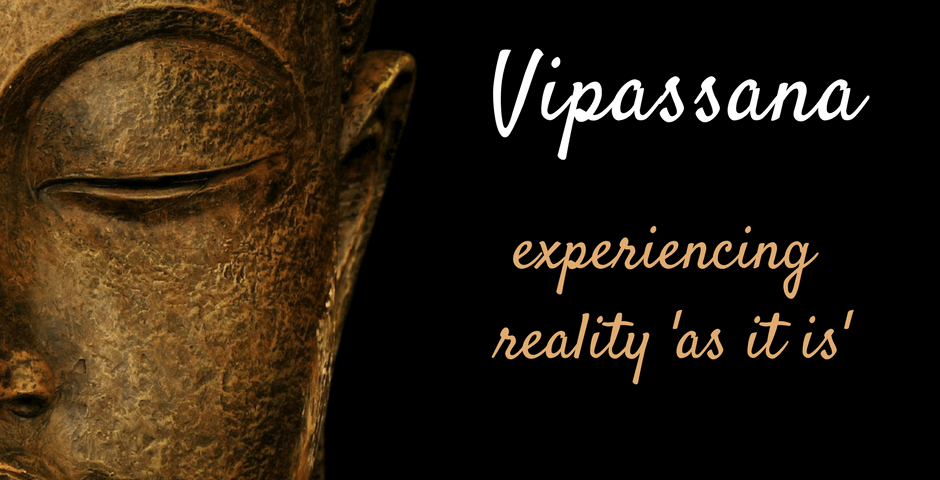
Benefits of Practicing Silence with Vipassana
- Mental clarity and calmness
- Emotional balance and reduced reactivity
- Self-discovery and deep self-awareness
- Disinterest in ego-driven or unnecessary desires
- Better compassion and understanding
Vipassana and Enlightenment
Enlightenment doesn’t come from escaping life, but from seeing it as it is. Vipassana brings hidden truths into focus; however, attaining enlightenment in Vipassana is not a sudden insight. The process unfolds layer by layer, bringing clarity with consistent practice. Firstly, people must come to experience dukkha (suffering), anicca (impermanence), and anatta (non-self) practically. Only through a deep realization of these experiences, the mind become free and guided to the path of enlightenment.
How to start Vipassana
Start practicing daily silent sitting for 10–15 minutes a day. Slowly increase the time.
Attend a 10-day retreat at the Vipassana retreat centers.
To learn more about Vipassana, read books by renowned teachers such as The Art of Living: Vipassana Meditation as Taught by S.N. Goenka, by William Hart, Mindfulness in Plain English by Bhante Henepola Gunaratana, Vipassana and the Scientific Worldview, by Paul R Fleischman, etc.
Furthermore, learn through visual learning- watch videos and talks on Vipassana, such as S.N. Goenka’s introductory talks (YouTube or Dhamma.org).
Develop a daily practice after attending retreats for deep transformation and attaining mental peace and enlightenment.
How Vipassana Works
Vipassana is simply a non-religious practice grounded in ethical living (Sīla), mental discipline (Samādhi), and wisdom (Paññā). Vipassana retreat generally follows a strict daily schedule, including:
Mindful breathing (Anapana) to focus the mind.
Body scanning to develop awareness of physical sensations.
Understanding impermanence (anicca or anitya) allows the mind to detach from desire and hatred.
Silence to lessen distraction and deepen inner observation.
Final Thoughts
In a society that is keen on speaking out, Vipassana invites us to turn inward and listen. To observe without reacting, to sit in silence and discover the depth of our being. Through self-silence, we don’t escape the world, but we understand it ‘as it is’. Practicing Silence with Vipassana transforms our relationship with suffering, and in that transformation, we find the seeds of freedom.
Written By: Anjali B
Mudras for Calming the Mind
Inner peace and a calm mind are tough to experience in this present hectic world. It has become a great necessity to soothe a restless mind and body. People use different methods for calming the mind and attaining inner peace. One of the easiest yet most effective proven methods is using various mudras while practicing meditation. These simple methods are easy to use and have barely any side effects. Hence, we present a blog on Mudras for calming the mind to use during meditation to attain energy flows within the body. We also further explore how to do the different mudras (hand gestures) practices, their benefits, and potential side effects. The best part of practicing these mudras is that you can use them anywhere, at any time, for calming the mind.
What Are Mudras?
In a simple word, Mudras are a combination of subtle physical movements. It alters mood and perception, further enhancing concentration and awareness. Mudra translates to ‘gesture’ or ‘an attitude’. Furthermore, it is described as psychic, emotional, devotional, or aesthetic gestures. Seal, short-circuit, or circuit-by-pass are some other defining terms for Mudra. In yoga and meditation, mudras help to influence the flow of energy (prana) and stimulate different parts of the body and mind.
Types of Mudra Techniques
Normally, we classify them as two Mudra techniques:
- Simple Hand Positions
- Whole-body combination (asana, pranayama, bandha, and visualization)
5 Mudras for Calming the Mind
Gyan Mudra | Mudra of Knowledge
An essential, widely practiced Science mudra symbolizes the mind and brain union. It is also known as Saraswati Mudra.
Popular as: Chin Mudra
Combination Element: Air and Fire
Fingers used: Index finger and Thumb
Activates: Sahasrara (Crown Chakra)
Steps:
- Sit comfortably in a Lotus pose with a straight spine.
- Join the tip of the index finger to the tip of the thumb.
- Keep the other three fingers straight and relaxed.
- Place hands on knees, palms facing up.
- Relax and meditate for a few minutes.
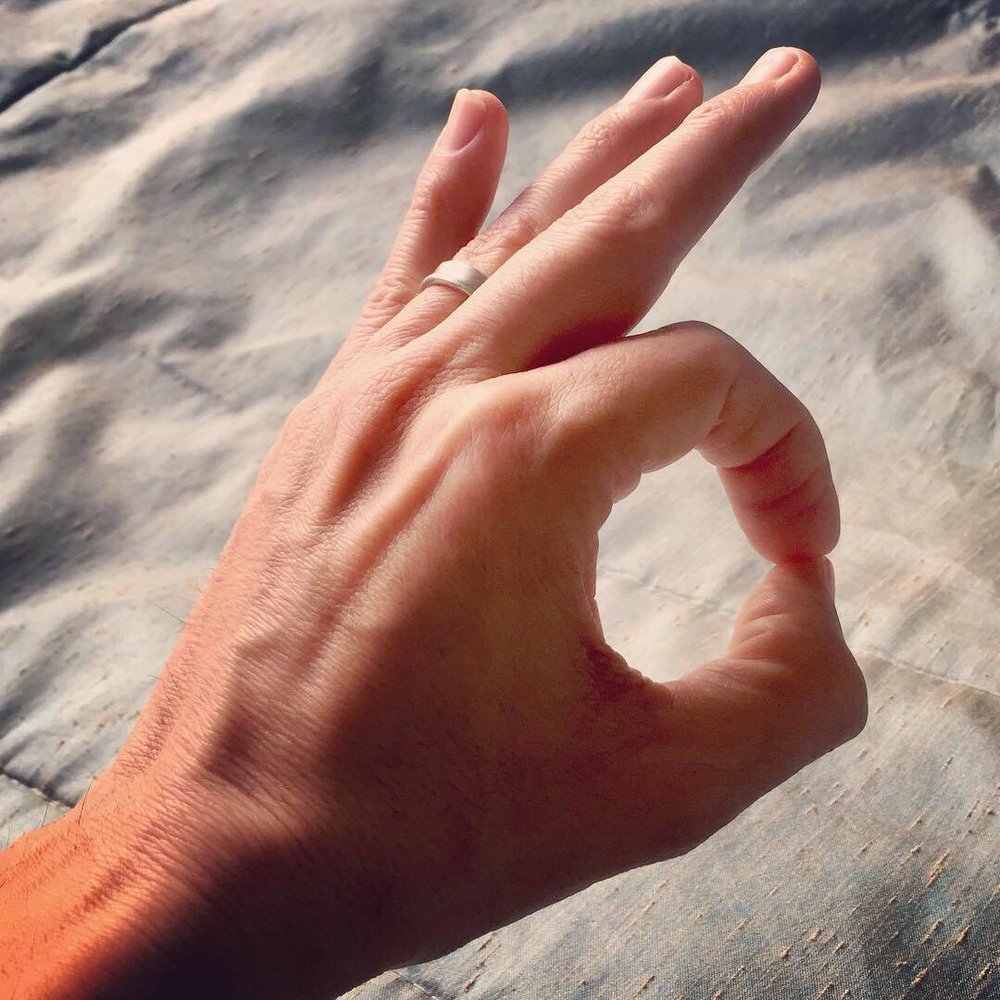
Gyan Mudra Benefits
- Activates different brain glands (Pineal, Pituitary, and Hypothalamus)
- Creates energetic balance between the mind and the body
- Improves memory and concentration, promoting intellect
- Calms the mind, overcomes addictions, and boosts positive thoughts
- Improves intuition as it activates the third-eye chakra
- Reduces anxiety symptoms and promotes emotional balance
- Excellent stress buster to help release hypertension, heart disease, insomnia, etc.
Gyan Mudra Side Effects
- Rarely any, but avoid using by overthinkers
Shuni Mudra | Mudra of Patience
A vital mudra for overthinkers, which helps to make people stay focused in the present and increases concentration. It reinforces the air and fire elements in the body.
Popular as: Saturn Mudra
Combination Element: Space and Fire
Fingers used: Middle finger and Thumb
Activates: Manipura (Solar Plexus Chakra)
Steps:
- Sit relaxed in padmasana (lotus pose) or any comfortable asana.
- Join the top of the middle finger to the tip of the thumb.
- Keep the remaining fingers straight.
- Rest your hands facing up on your knees.
- Close your eyes and meditate for a few minutes.

Shuni Mudra Benefits
- Encourages patience, discipline, and compassion
- Activates sensory and intuition powers
- Purifies the mind and the body
- Good for digestion, increases metabolism
- Calms the mind, reducing impulsivity and stress
- Healthy, glowing skin and clear eyes
- Boosts will power and confidence
Shuni Mudra Side Effects
- Avoid when feeling emotionally overwhelmed
Prana Mudra | Mudra of Life Force
The powerful mudra is the union of water, fire, and air elements, which is the combination of Prithvi and Indra tattva mudras. Regular practice of Prana mudra creates a reservoir in the body and regulates the prana vayu in the body.
Popular as: Vital Energy Mudra
Combination Element: Earth, Water, and Fire
Fingers used: Ring finger, Little finger, and Thumb
Activates: Muladhara (Root Chakra) and Anahata (Heart Chakra)
Steps:
- Sit comfortably in cross-legged or lotus pose with your spine straight.
- Join the tip of the ring and little finger to the tip of the thumb.
- Keep your index and middle fingers straight.
- Rest your hands on your knees, palms facing upward.
- Relax and meditate for a few minutes.
Prana Mudra Benefits
- Enhance mental clarity by improving memory and concentration
- Reduce fatigue and rejuvenate the body
- Strengthen the immune system and vitality
- Clean out blood vessels, arteries, and veins
- Relief from respiratory diseases
- Effective mudra for the heart and lungs
- Good for curing eye diseases (dry eyes, red eyes, etc.)
Prana Mudra Side Effects
- Avoid if you have hypertension issues, and during pregnancy
Dhyana Mudra | Mudra of Meditation
A very significant mudra that energizes the Pran Shakti. It creates a balance and harmony between all 5 elements in the body. It is also known as Brahmanjali Mudra.
Popular as: Samadhi Mudra
Combination Element: Air
Fingers used: Thumb
Activates: Sahasrara (Crown Chakra) and Ajna (Third Eye Chakra)
Steps:
- Sit comfortably with straight posture.
- Place your left hand on your lap, facing upward.
- Place the back of the right hand over the left, facing up.
- Slowly touch the tips of both thumbs, forming a triangle shape.
- Close your eyes, relax, and meditate in this mudra for a few minutes.
Dhyana Mudra Benefits
- Calms the mind, minimizing hyperactive thoughts
- Improves concentration powers
- Proper heart functioning regulates palpitations
- Helps to maintain a balance for both low and high pressure
- Calms the nervous system, helping to reduce stress, fear, etc.
- Proper balance between both right and left brain
- Supports in awakening the conscious and spiritual level
Dhyana Mudra Side Effects
- Sitting in the same posture for a longer period may cause pain in the legs
Apana Vayu Mudra | Heart Calming Mudra
The perfect mudra for a healthy heart is a combination of apana (downward flowing energy) and vayu (air). It is also known as a “first aid” mudra during panic or stress attacks.
Popular as: Mritsanjeevani Mudra
Combination Element: Earth, Space, and Fire
Fingers used: Ring finger, Middle finger, and Thumb
Activates: Anahata (Heart Chakra) and Muladhara (Root Chakra)
Steps:
- Sit in a Padmasana or any comfortable asana.
- Curl your index finger into the base of the thumb.
- Join the tips of the middle and ring fingers with the tip of the thumb.
- Keep the little finger straight.
- Rest the palm facing up on your knees.
- Relax and start to meditate for a few minutes.
Apana Vayu Mudra Benefits
- Proper heart functioning with regulatory circulation
- Improves digestive issues
- Reduces mental tension and anxiety issues
- Calms the mind, promoting mental clarity
- Develops emotional balance by releasing fear
- Boost stability and harmony within the body
- Clear energetic blockages in the chest and abdominal areas
Apana Vayu Mudra Side Effects
- Not recommended for certain heart conditions or low blood pressure
Conclusion
Mudras are simple tools for calming the mind. The right use of mudras while practicing meditation brings mental clarity and emotional balance. Incorporate mudras in your daily meditation routine or practice if you are feeling stressed or dealing with emotional turmoil. Practice daily with mudras, start small, and stay consistent. Gradually, a positive effect on the mind, body, and soul is visible. As a result, experience the calming mind and mental clarity with overall energetic balance.
Frequently Asked Questions (FAQs)
How long should you practice the Mudras?
It is ideal to practice each mudra for 5 to 15 minutes.
When to practice?
You can practice daily during meditation in a mindful state or when feeling stressed or overwhelmed.
How to practice it?
You can just sit in a comfortable position and practice. You can also combine mudras with deep breathing or mantras for greater effect.
Are there any precautions and side effects?
Don’t overdo it to maintain a balance and good flow of energy.
When not to practice the Mudras?
If you are not feeling well, highly energized, or overly mentally distressed, don’t practice the mudras.
Written By: Anjali B
Top 7 Yoga Asanas for Weight Loss and Fighting Obesity
Yoga is slowly gaining popularity, which is resulting in it becoming a fundamental part of human beings’ lives. In the present world, health is deteriorating physically, mentally, and spiritually due to our hectic schedules and busy lives. A busy schedule is leading for an individual to unhealthy eating and sleeping habits. As a result, there is a rapid growth in obesity and weight gain among the people. Indeed, it has become a serious global issue. Many people have followed different ways to lose their weight and fight obesity. Among several ways, practicing Yoga has proven a boon and one of the safest natural methods. Therefore, we present the top 7 yoga asanas for weight loss and fighting obesity to incorporate in your daily life to reduce stress, improve metabolism, burn fats, and enhance overall body function. It contributes to a sustainable and balanced approach to weight management.
Below, we have listed 7 beneficial yoga asanas for weight loss and fighting obesity, each with its steps, benefits, and side effects.
Top 7 Yoga Asanas for Weight Loss and Fighting Obesity
A. Vajrasana (Thunderbolt Pose)
Vajrasana is an asana where your body posture involves sitting on the knees with the calves underneath the thighs. It is also popular as the Thunderbolt or Diamond pose. This asana is derived from the Sanskrit word ‘Vajra,’ which translates to thunderbolt. There is a variety of asanas described under Vajarsana in ancient texts. In hatha yoga, it is a kneeling asana.
Steps
- Kneel on the mat, and put your toes together and heels apart.
- Rest on the balls of your feet and place the gap in between your heels.
- Set your hands in Jnana or Chin Mudra and place them on the knees.
- Keep your back straight and close your eyes.
- Hold for 30 seconds to a few minutes, focusing on deep and sound breathing.
- Slowly come out of this pose by sitting back and lengthening your legs straight out in front of you to release.
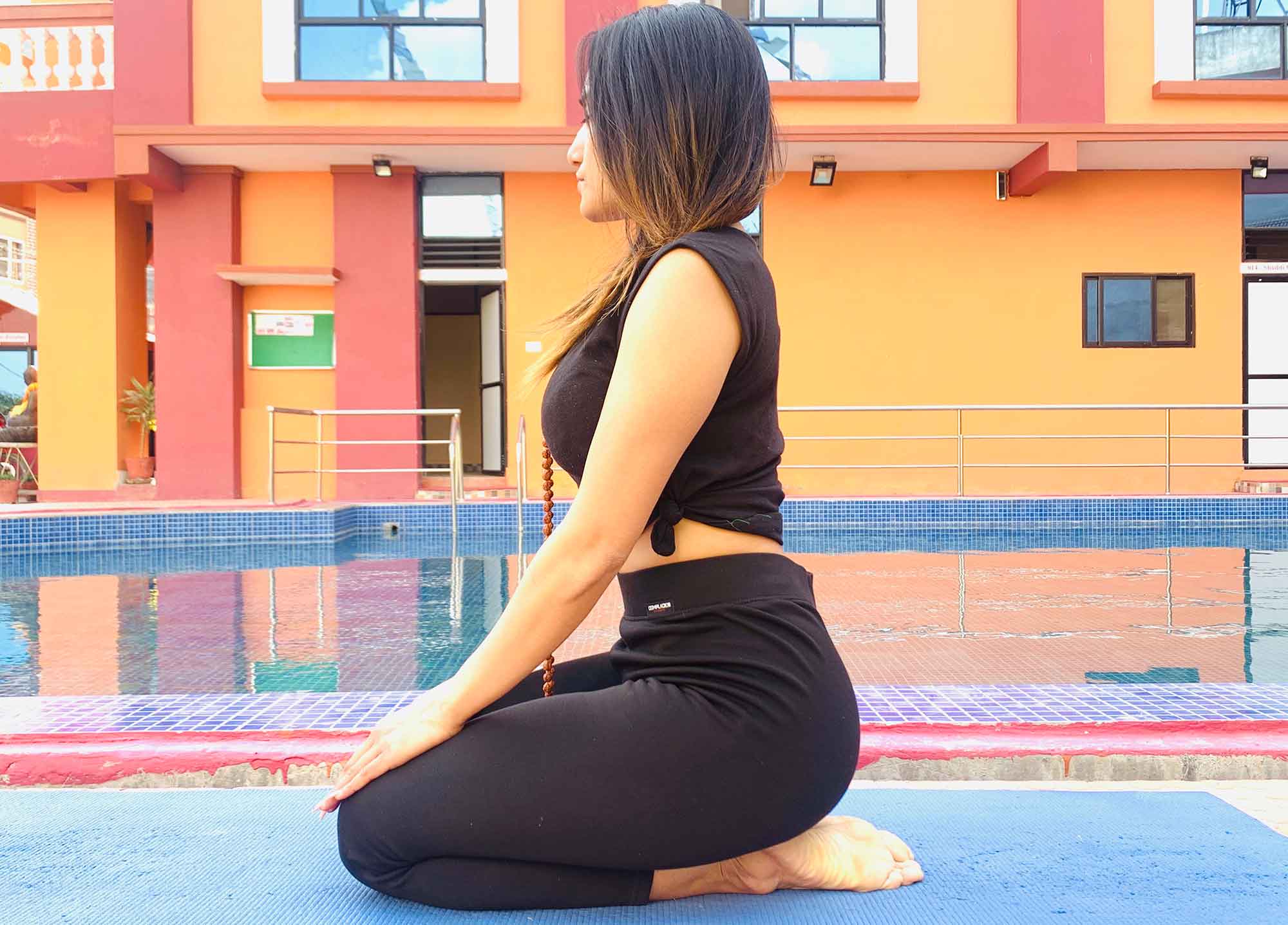
Vajrasana Benefits
- Reduces stress and calms the mind
- Aids digestion after meals
- Reduces bloating, supports weight loss
- Strengthens the lower body with regular practice
Vajrasana Side Effects
- Avoid if you have knee or ankle ligament injuries
- People with severe arthritis, ulcers, or hernia mustn’t attempt
B. Surya Namaskar (Sun Salutation) Asana Series
Surya Namaskar is a flowing sequence of 12 asanas that synchronizes with breathing. It is a complete exercise for the whole body. It is also known as the Sun Salutation or Salute to the Sun. For spiritual connections, many practitioners chant mantras along with each asana.
Steps
Stand in front of the mat.
Sthita Prarthanasana (Standing Prayer Asana): Stand straight, keeping your head straight and shoulder relaxed. Join your hands in Anjali mudra at the heart center. Compose yourself and take a deep breath.
Hasta Uttanasana (Raised Arm Asana): Inhale and raise both your arms above your head and bend back slightly.
Hasta Padasana (Hands to Toe Asana): Exhale and bend forward slowly to touch your toes or feet with your hands.
Ashwa Sanchalanasana (Equestrian Asana): Inhale and take your right leg back. Keep your left leg bent at 90 degrees and hands on the ground. Arch your spine and face upward.
Adhomukha Shvanasana (Downward Dog Asana): Exhale and step your left leg beside the right. At the same time, lift your hips into an inverted V-shape, bringing your head in between your arms.
Ashtanga namaskar (Eight-limb Asana): Retain your breath and lower your knees, chest, and chin to the mat. Keep your hips slightly raised.
Urdhvamukha Shvanasana (Upward Dog Asana): Inhale and slide forward, lifting the head from the ground. Keep your chest and lower body on the ground and look upward.
Repeat the asanas from 1 to 5 in reverse order.
Adhomukha Shvanasana (Downward Dog Asana): Exhale and slowly raise your hips upward. Form your hips into an inverted V-shape, bringing your head in between your arms.
Ashwa Sanchalanasana (Equestrian Asana): Inhale and bring your right foot forward, placing both hands on the ground. Lift the chest and stare forward.
Hastapadasana (Hands to Leg Asana): Exhale and bring both legs together with head in.
Talasana (Raised Arm Asana): Inhale and come back straight. Raise both arms overhead, lengthening the spine.
Sthita Prarthanasana (Standing Prayer Asana): Exhale and bring hands back to the heart center in Anjali mudra. Return to the standing prayer position, composed and balanced.
Repeat the same 12 asanas with another leg to complete one round. (Only perform as your will and stamina allow.)
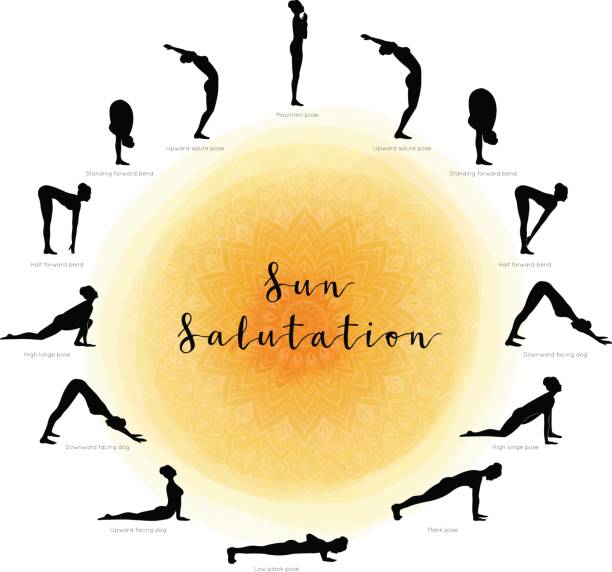
Surya Namaskar Benefits
- Calories and fat burns with a full-body workout
- Improves posture and balance
- Promotes mental clarity and focus
- Boosts energy and circulation
- Enhances flexibility and strength
Surya Namaskar Side Effects
- Overdoing is restricted
- Rapid practice causes dizziness or fatigue
C. Naukasana (Boat Pose)
Naukasana is an asana where your body forms a “V” shape or a boat shape while balancing on your sit bones, lifting your legs and arms. Hence, it is also called a Boat pose. This asana is derived from the Sanskrit word paripūrṇa, which means boat. The other names for this asana are Navasana or Paripūrṇanāvāsana.
Steps
- Sit on the mat with your legs extended straight and your feet together.
- Bend your knees and lean your torso back.
- Extend your arms in front of you and gently raise both legs.
- Keep your thighs at a 45-degree angle and your arms parallel to the floor.
- Stay in the Boat Pose, forming a “V” shape with your body.
- Gaze at the toes or nose for as long as you can, breathing deeply.
- Release the pose, straighten your legs, and relax.

Naukasana Benefits
- Improves our digestive and reproductive systems
- Burns belly fat and strengthens the Body Muscles
- Make stronger abs, hips, and lower back
- Calms Mind and releases stress
- Improves focus and concentration
Naukasana Side Effects
- Overstretching may strain the lower back or hips
- Improper head alignment causes neck injury
D. Dhanurasana (Bow Pose)
Dhanurasana is an asana where the body posture creates a bow-like shape. This asana is derived from the Sanskrit word ‘dhanur’ which translates bow. Thus, it is also called the Bow pose. It is described as a back-bending asana in hatha yoga
Steps
- Lie flat on your stomach with your legs bent, bringing your ankles toward your buttocks.
- Reach back and hold your ankles with your hands as you inhale.
- Arch the back, lifting the thighs, chest, and head together, and exhale.
- Lift your gaze and raise your feet.
- Carefully bring your ankles close to your buttocks.
- Stretch your arms and hold your ankles, and breathe.
- Make sure you balance on your stomach.
- Exhale, and slowly come back to the ground.
- Lower the head, chest, and legs, and relax.
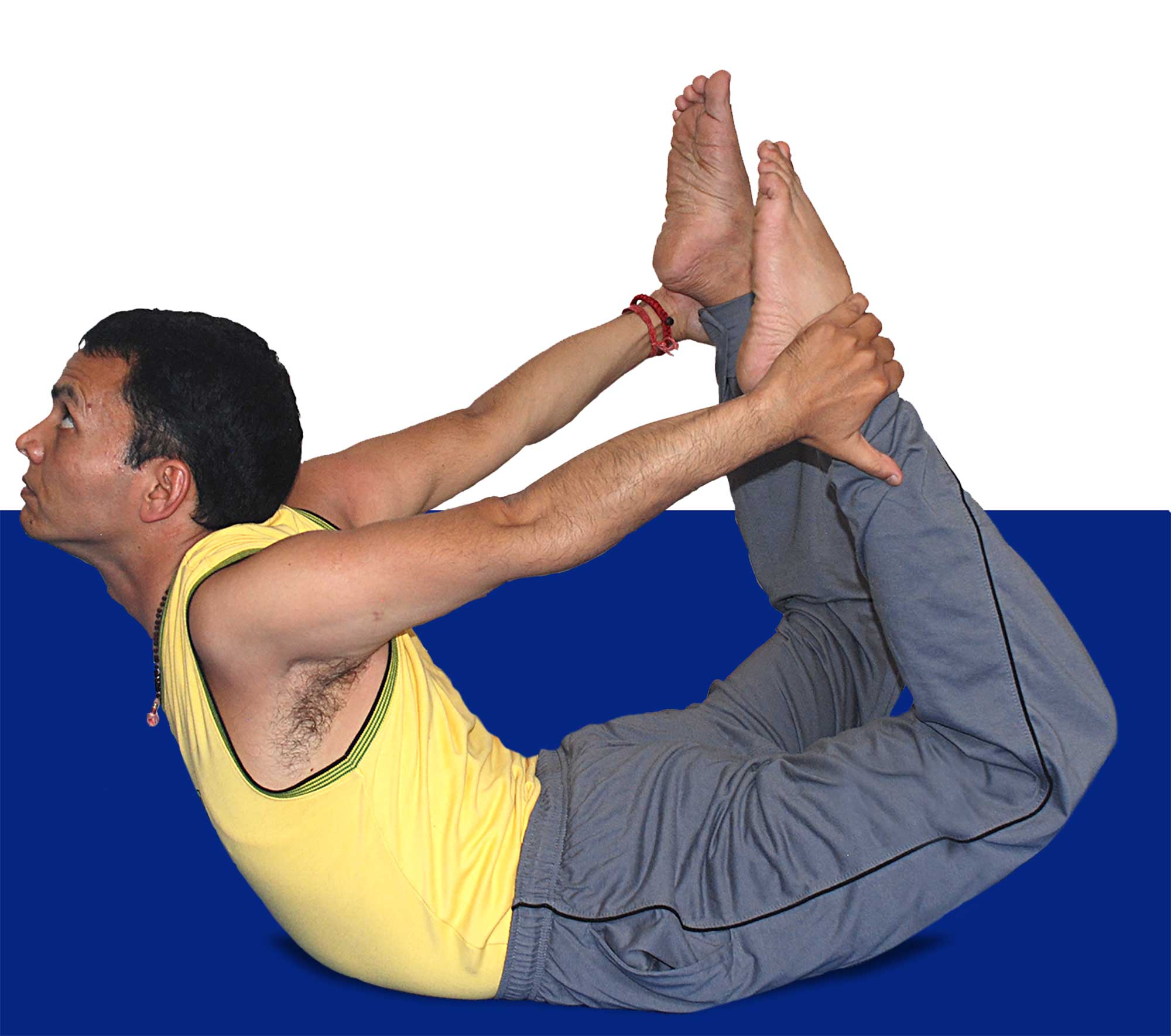
Dhanurasana Benefits
- Decreases Abdominal Fat
- Better Digestion
- Cure for Fatigue
- Activates Manipura Chakra
- Flexible Hip Joints
Dhanurasana Side Effects
- Avoid during pregnancy, high or low blood pressure, and with abdominal surgeries
- Don’t practice if you have neck injury, lower back concerns, hernia, and migraine headaches
E. Trikonasana (Triangle Pose)
Trikonasana is an asana where the body parts: hands, legs, and backbone form a triangle shape. Hence, it is also called the Triangle pose. This asana is derived from the Sanskrit word Utthita Trikonasana (Extended Triangle Pose). Baddha Trikonasana (bound triangle pose) and Parivrtta Trikonasana (revolved triangle pose) are its variations.
Steps
- Stand straight on the mat with medium stance (about 3 to 4 feet).
- Inhale and stretch your arms at shoulder level.
- Rotate your right foot out 90 degrees and left foot in by 15 degrees and exhale.
- Place your right hand on your right shin bone.
- Raise your left hand upward and gaze at your left thumb.
- Keep taking long, deep breaths.
- Inhale, bend the right knee, and resume the standing position.
- Repeat the same process facing right or using left side.
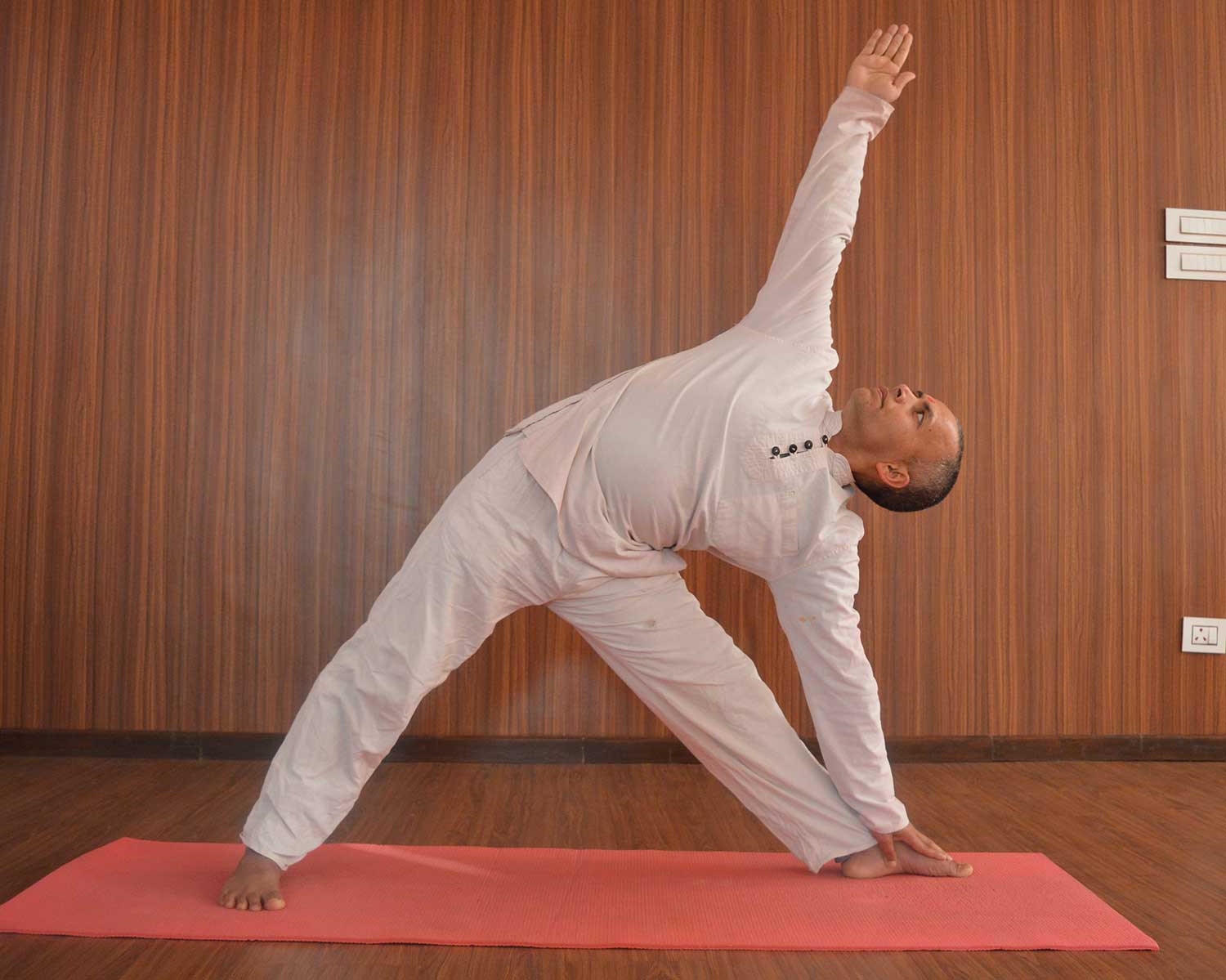
Trikonasana Benefits
- Stretches the legs, hips, and spine
- Fat loss around the waist and thighs
- Balance and coordination improves
- Stimulates digestion and relieves stress
- Opens the chest and promotes deep breathing
Trikonasana Side Effects
- Incorrect alignment causes strain to the lower back, hamstrings, or neck
- Overextension is avoided, especially with tight hips or legs
F. Bhujangasana (Cobra Pose)
Bhujangasana is an asana where the upper part of your body is elevated above the ground same as a Cobra raising its hood. Therefore, it is also called the Cobra pose. It is classified as a reclining back-bending asana in hatha yoga.
Steps
- Lie down on your stomach and bring your chin to the mat.
- Place your palms under the shoulder and inhale.
- Lift your chest while your hips remain on the floor.
- Breathe, relax your shoulders down away from the ears
- Press your chest forward and exhale.
- Gently lower your chest and bring your chin to the mat.
- Rest your arms down by the sides and relax.
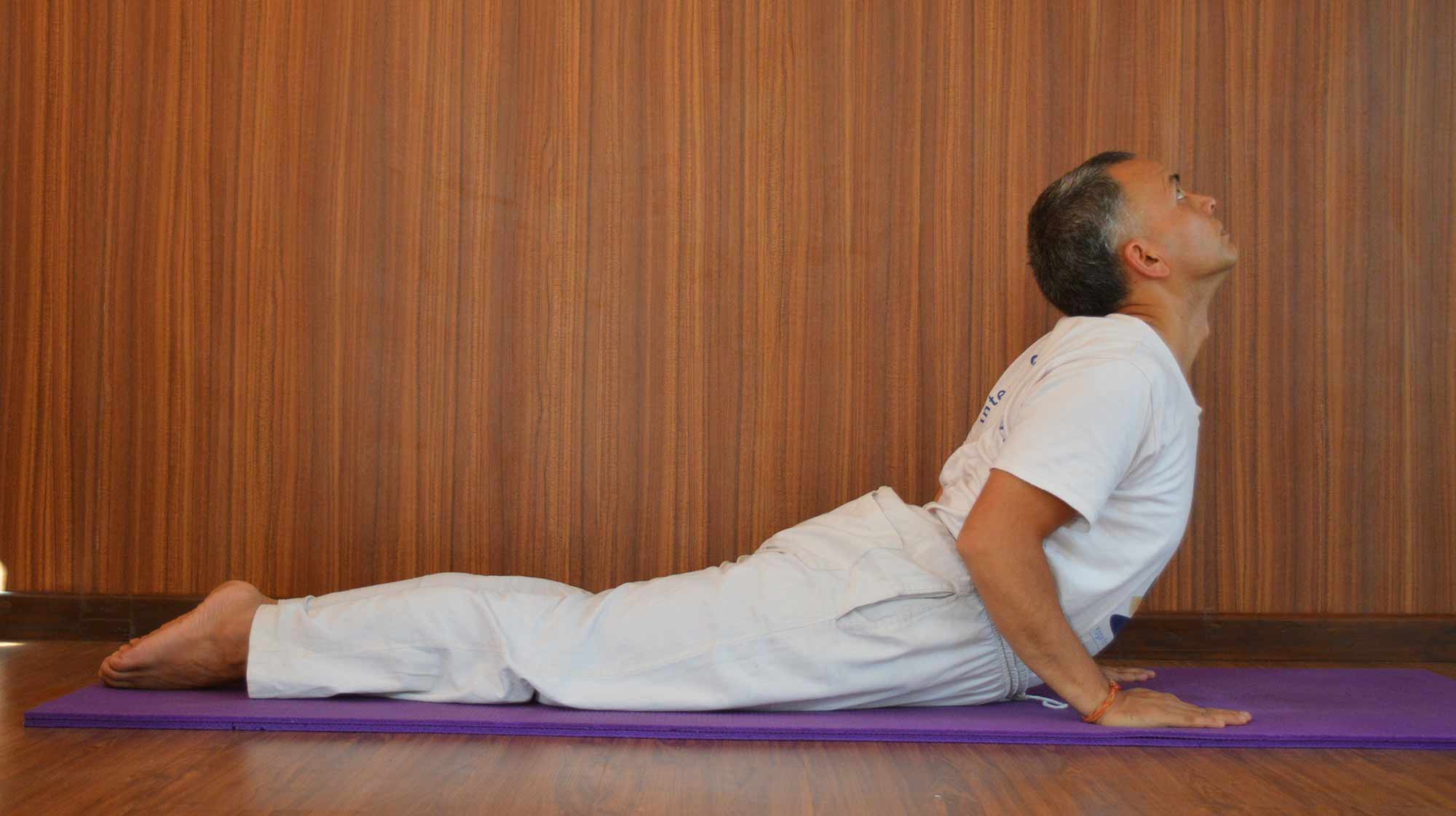
Bhujangasana Benefits
- Strengthens the spine, arms, and shoulders
- Regular practice burns belly fat
- Stimulates the heart and lungs, improving circulation
- Control in Menstrual and gynecological disorders
- Promoting better digestion and easing constipation
Bhujangasana Side Effects
- Avoid with spine issues or during pregnant
- Strictly restricted for hernia, peptic ulcer, hyperthyroidism, or intestinal tuberculosis patients
G. Setu Bandhanasana (Bridge Pose)
Setu Bandhanasana is an asana where the posture of your body becomes like a bridge. Thus, it is also popular as the Bridge pose. The full name of this asana is Setu Bandha Sarvāṅgāsana. In hatha yoga, it is an inverted back-bending asana.
Steps
- Lie on your back and join your legs.
- Bent your knees and bring heels nearer the buttock.
- Hold your ankles firmly and inhale.
- Slowly raise your buttocks.
- Trunk as high as you can to form a bridge.
- Stay comfortably in the pose for 15-30 seconds while breathing.
- Slowly exhale and return to the original position.
- Relax down on your back.

Setu Bandhanasana Benefits
- Tones the core, glutes, and thighs, helping burn fat
- Improves posture and opens rounded shoulders
- Improves digestion and thyroid glands
- Develop the female reproductive organs
- Reduces anxiety and insomnia
Setu Bandhanasana Side Effects
- Don’t practice during pregnancy or neck injury
- Patients with Hernia, Peptic or duodenal ulcers must avoid
Conclusion
These top 7 yoga asanas are not only beneficial for weight loss and fighting obesity but also promote the entire body and mind function. Practicing daily improves digestion, enhances metabolism, and builds up muscles. As a result, it helps burn fat, resulting in weight loss. Fighting obesity is a tough task, but with strong determination, discipline, and routine daily practice, it is achievable. So, start practicing these yoga asanas to stay fit and healthy.
Written By: Anjali B
